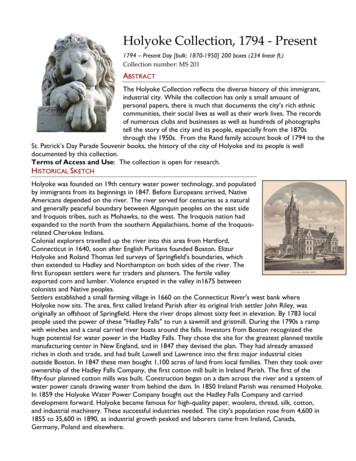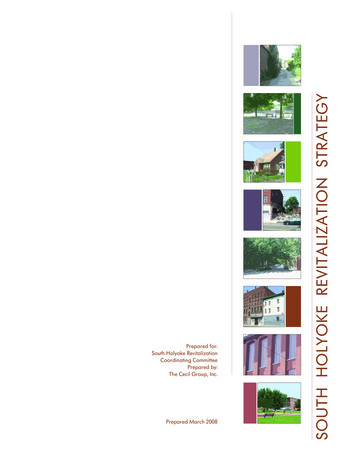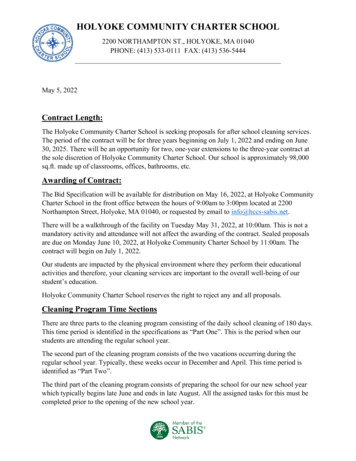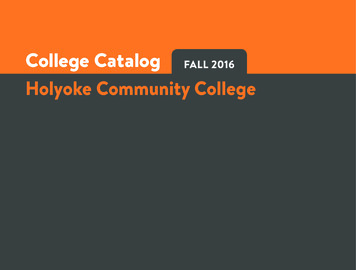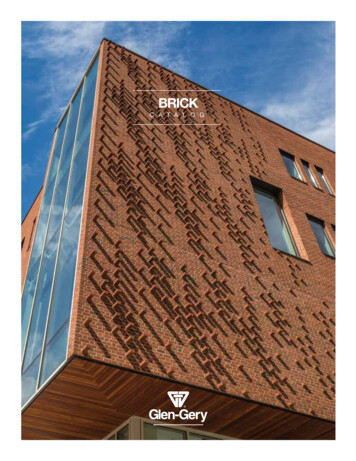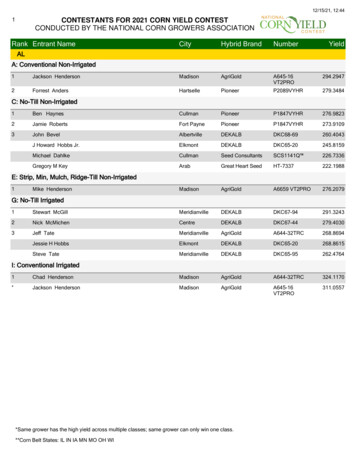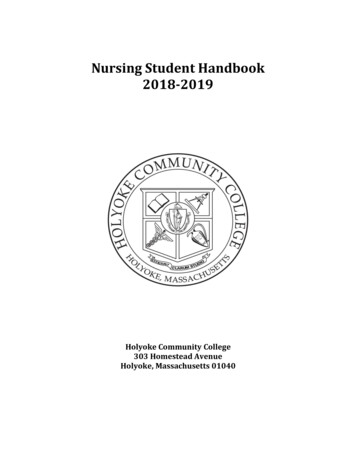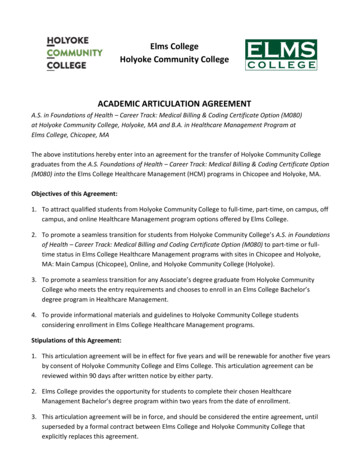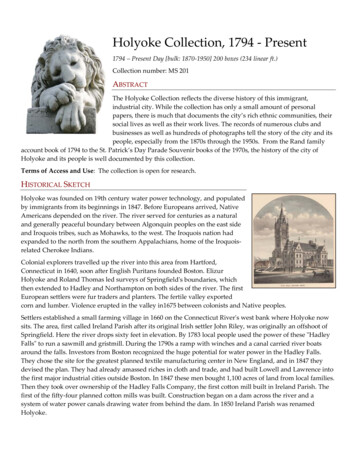
Transcription
Holyoke Collection, 1794 ‐ Present1794 – Present Day [bulk: 1870‐1950] 200 boxes (234 linear ft.)Collection number: MS 201ABSTRACTThe Holyoke Collection reflects the diverse history of this immigrant,industrial city. While the collection has only a small amount of personalpapers, there is much that documents the city’s rich ethnic communities, theirsocial lives as well as their work lives. The records of numerous clubs andbusinesses as well as hundreds of photographs tell the story of the city and itspeople, especially from the 1870s through the 1950s. From the Rand familyaccount book of 1794 to the St. Patrick’s Day Parade Souvenir books of the 1970s, the history of the city ofHolyoke and its people is well documented by this collection.Terms of Access and Use: The collection is open for research.HISTORICAL SKETCHHolyoke was founded on 19th century water power technology, and populatedby immigrants from its beginnings in 1847. Before Europeans arrived, NativeAmericans depended on the river. The river served for centuries as a naturaland generally peaceful boundary between Algonquin peoples on the east sideand Iroquois tribes, such as Mohawks, to the west. The Iroquois nation hadexpanded to the north from the southern Appalachians, home of the Iroquois‐related Cherokee Indians.Colonial explorers travelled up the river into this area from Hartford,Connecticut in 1640, soon after English Puritans founded Boston. ElizurHolyoke and Roland Thomas led surveys of Springfieldʹs boundaries, whichthen extended to Hadley and Northampton on both sides of the river. The firstEuropean settlers were fur traders and planters. The fertile valley exportedcorn and lumber. Violence erupted in the valley in1675 between colonists and Native peoples.Settlers established a small farming village in 1660 on the Connecticut Riverʹs west bank where Holyoke nowsits. The area, first called Ireland Parish after its original Irish settler John Riley, was originally an offshoot ofSpringfield. Here the river drops sixty feet in elevation. By 1783 local people used the power of these ʺHadleyFallsʺ to run a sawmill and gristmill. During the 1790s a ramp with winches and a canal carried river boatsaround the falls. Investors from Boston recognized the huge potential for water power in the Hadley Falls.They chose the site for the greatest planned textile manufacturing center in New England, and in 1847 theydevised the plan. They had already amassed riches in cloth and trade, and had built Lowell and Lawrence intothe first major industrial cities outside Boston. In 1847 these men bought 1,100 acres of land from local families.Then they took over ownership of the Hadley Falls Company, the first cotton mill built in Ireland Parish. Thefirst of the fifty‐four planned cotton mills was built. Construction began on a dam across the river and asystem of water power canals drawing water from behind the dam. In 1850 Ireland Parish was renamedHolyoke.
WISTARIAHURST MUSEUMHOLYOKE COLLECTION FINDING AIDIn 1859 the Holyoke Water Power Company bought out the Hadley Falls Company and carried developmentforward. Holyoke became famous for high‐quality paper, woolens, thread, silk, cotton, and industrialmachinery. These successful industries needed. The cityʹs population rose from 4,600 in 1855 to 35,600 in 1890,as industrial growth peaked and laborers came from Ireland, Canada, Germany, Poland and elsewhere.Holyokeʹs water power canal system, the largest in New England, carried water from the river to drive theturbines in the mills. From 1847 to 1893 workers dug the 4 112 mile canal system using picks and shovels! Inorder to power the mills, a dam across the Connecticut River was needed to force water into the cityʹs systemof canals. The first attempt to dam the river began in 1847. Construction took a year. The 1000‐foot‐Iong timberstructure broke and washed downriver as soon as it was completed. The telegraph to the Boston Investorsread: ʺYour old dam has gone to hell by way of Willimansett.ʺ In 1849 five hundred laborers completed asecond and stronger wooden dam, which held. The present stone dam was built in the 1890s, replacing theolder wooden dam, and began service in 1900. Over a thousand feet long and thirty feet high, it is filled withcemented stone rubble and faced with granite blocks from Vinal Haven, Maine and local quarries. The stonedam has had major repairs once, after the flood in 1936, which sent 14 feet of water over its top. Otherwise thedam has functioned unchanged since its construction.Holyokeʹs fame as ʺpaper cityʺ arose in the 1880s when it became the worldʹs largest producer of fine writingpapers. In 1899, 16 mills formed the American Writing Paper Company, a price‐controlling trust, or coalition.Parsons Paper Company was the first established paper mill in 1853 and was the last mill in Holyoke tomanufacture paper, closing in 2004. The mills ran 24 hours, 7 days a week, with two shifts. Hand labor wasdone by women while men ran the machinery. Eagle Lodge, the national papermakerʹs union, was founded inHolyoke in 1884 to address grievances about wages and hours. There are still several ʺpaper convertingʺcompanies manipulating paper that is made elsewhere.Lyman Mills, named for a Boston investor, opened in 1854, made quality cotton fabrics, and employed 1500people at its peak in the 1890s. It closed in 1927 as textile industries moved south. The Skinner Silk Mills, inoperation from 1874 to 1963, produced silk thread, bridal satin and silk and nylon for parachutes used inWorld War II. Germania Mills opened in 1865 to make heavy woolens for overcoats and suits. Their reputationwas built on fashionable woolens, but innovations in home and auto heating swayed fashions to lighter suitsand coats. The mill closed in the 1960s. Farr Alpaca used llama wool to develop Holyokeʹs largest textilecompany. In 1910 its 4,000 employees produced mohair and cashmere cloth. The companyʹs security rested onits manufacture of quality alpaca wool linings and its adaptation to changing fashions, but it finally closed inthe 1930s. Holyoke mills excelled in the manufacturing of high‐quality spool thread for sewing. The HadleyCompany produced the first American thread during the 1860s that was good enough to challenge Englishproducts. The Merrick Thread Company achieved such success that other American companies during the1880s attempted to undersell them by forming a ʺthread trust,ʺ or combination of companies large enough toinfluence prices.In 1920 the city of Holyoke contained: 17,557 workers earning 12 million/year; Railroad freight tonnagesecond only to Boston; 10 banks worth 32 million; Turbines producing 30,000 horsepower; the lowest electricrates in New England. In a single day, Holyoke .produced: 2 million envelops, 150 miles of cloth, 500 tonswriting paper, and 100,000 miles of threadBusiness, labor organizations and civic groups played an important role in the lives of the cityʹs residents,creating the backbone for Holyokeʹs economic and social growth. Residents enjoyed sports and recreation,despite 6 day work weeks and 12 hour shifts. Volleyball was invented in Holyoke in 1895. Several local menfounded professional baseball clubs. Many churches, schools and mills had teams. Bicycle racing was aPage 2
WISTARIAHURST MUSEUMHOLYOKE COLLECTION FINDING AIDpopular pastime. Valley Arena, known for its boxing and big band music, was a popular night spot during the1940s and 1950s. Mountain Park, a few miles out of town, offered family entertainment until it closed in 1988.Its classic Merry‐Go‐Round now has a downtown home at Heritage Park.Irish immigration, starting with the Irish potato famine in 1847, continued in large numbers for severaldecades. Because 1847 marked the initial construction of the dam and city, the labor force in Holyoke waslargely made up of immigrants from the start. The Irish managed to secure many of the more skilled andlucrative positions in the paper mills. They advanced into positions of control in politics and the fire and policedepartments. 1859: French‐Canadians were first recruited to fill labor shortages, triggering immigration thatpeaked between 1875 and 1900. French‐Canadians, arriving later than the Irish, filled the ranks of lower‐paidtextile workers. Many Irish young people heeded parental advice and chose lives outside Holyokeʹs factoriesin the 1950s. French‐Canadians filled the openings, enjoying some upward mobility near the end of theindustrial era. Immigrants from England, Scotland and Germany were drawn to the mills in Holyoke. 1890:Holyoke had a population of 36,600, with 48% foreign‐born. 1917: The population rose to 62,210, and by the1900s Russians, Jews and Italians were coming to the city. Many Polish immigrants earned enough money inthe mills to buy farmland in the valley. African‐Americans moved to the city during World War I. 1960: PuertoRican families began moving to Holyoke, beginning the most recent influx of new residents. Some earlymigrants stayed after working seasonal agricultural jobs. Farm jobs were fast disappearing, along with factorywork. Available housing attracted families displaced by urban renewal in Springfield in the 1960s. TodayLatinos compose almost one third of Holyokeʹs population and three quarters of the public school studentbody.SCOPE AND CONTENTS OF THE COLLECTIONDocuments related to the activities of the Holyoke Street Railroad (1855‐1954) and its subsidiary, the Mt. TomRailroad, form an important part of this collection. Of particular significance are the records pertaining to thedevelopment and maintenance of Mountain Park, one of several “trolley‐car amusement parks” built adjacentto American cities just before and after the start of the twentieth century. Within the assorted family papers,the papers of local author Alma Honey are yet another rich source as are the Rand family papers. While therecords of more than thirty clubs can be found within the Holyoke Collection, the records of the HolyokeMusic Club (1899‐1984) and the Valley Players (1890‐1964) are especially extensive.The Collection has been arranged in the following 21 series:SERIES 1.BUSINESS & INDUSTRYSubseries A Companies A‐ZSubseries BBankingSubseries C Paper ManufacturingSubseries D Textile ManufacturingSubseries ELabor UnionsSERIES 2CEMETERIESSERIES 3CHURCHESSERIES 4CITY OF HOLYOKE OFFICIAL RECORDSSubseries A Annual ReportsSubseries BFire & Police DeptPage 3
WISTARIAHURST MUSEUMSubseries CSubseries DSubseries ESubseries FHOLYOKE COLLECTION FINDING AIDCity Departments A‐ZBoards and CommissionsCity Hall BuildingPublic School DeptSERIES 5CLUBS AND ORGANIZATIONS SEE ALSO SPORTS AND RECREATIONSubseries A Clubs and Organizations A – ZSubseries BHolyoke Music ClubSubseries C Junior League of HolyokeSubseries D KulturamaSubseries ESt. Patricks ParadeSubseries FThe Valley PlayersSERIES 6CONNECTICUT RIVER & WATER POWERSubseries A Dams, Canals, Water PowerSubseries BConnecticut River and FloodsSERIES 7EDUCATION/SCHOOLSSubseries A. Public, Private, Parochial SchoolsSubseries BHolyoke Community College (HCC)/Holyoke Junior CollegeSERIES 8FAMILIESSubseries ASubseries BSubseries CSubseries DSubseries ESubseries FSubseries GSubseries HSubseries ISubseries JSubseries KSubseries LFamilies A‐ZBachelder FamilyChapin Family see also: Gilson, Harvey, Judd, Kemp, Partridge, ToddDay Family of Ireland Parish see also Jones Ferry, Ely FamilyEly Family see also Day FamilyHoney, Alma CollectionJohnson and Miller FamilyParson FamilyRand FamilyStreet FamilyTaft Family see also Parsons and PrescottWhiting FamilyHISTORYSubseries ASubseries BSubseries CSubseries DSubseries ESubseries FSubseries GHolyoke HistoryHistoric EventsPublic Relations & PlanningCounty, State and National HistoriesNative AmericansGeologyNeighborhoods, BuildingsSERIES 9SERIES 10 HOLYOKE HOSPITALSERIES 11 HOLYOKE PUBLIC LIBRARYSERIES 12 IMMIGRATION & MIGRATIONPage 4
WISTARIAHURST MUSEUMSERIES 13 MEMORABILIASubseries AHOLYOKE COLLECTION FINDING AIDSummit House MemorabiliaSERIES 14 MILITARY HISTORYSERIES 15 NEWSPAPERSSubseries ASubseries BSubseries CTranscriptHolyoke Sun PhotographsOtherSERIES 16 PHOTOGRAPHSSubseries ASubseries BSubseries CSubseries DSubseries ESubseries FSubseries GSubseries HHolyoke PhotographsHolyoke Businesses PhotographsFamilies PhotographsMilitary and Grand Army of the Republic PhotosPeople & Group PhotographsParks PhotographsRailroadsMiscellaneousSERIES 17 POSTCARD COLLECTIONSERIES 18 SCRAPBOOKSSERIES 19 SPORTS AND RECREATION AND ARTSSubseries A Art & HistorySubseries BParksSubseries C SportsSERIES 20 STEREOCARDSSERIES 21 TRANSPORTATIONSubseries A Transportation A‐ZSubseries BHolyoke Street Railway (HSRCo)Subseries C Mt. Tom Railroad (MTRR)INFORMATION ON USETerms of Access and UseThe collection is open for research.Preferred CitationCite as: Holyoke History Collection, MS 201, Wistariahurst Museum, Holyoke, Mass.History of the CollectionDonated by various individuals throughout the community over the decades and throughlegal separation in City of Holyoke vs. Holyoke Public Library, 1986.Processing InformationProcessed by various curators and archivists over the decades.Page 5
WISTARIAHURST MUSEUMHOLYOKE COLLECTION FINDING AIDADDITIONAL INFORMATIONLanguages:EnglishSeparated MaterialsDuplicate materials, published works, city records publicly available elsewhere, non‐archivalbindings and folders, and paper clips have been duly removed from the collection.RELATED MATERIALSRelated materials may also be found in the following collections housed within the Five‐College area:Other papers , years, collection repositoryHistory of Holyoke, Massachusetts. Anna U. Scanlon 1939Holyoke, Massachusetts. Constance McLaughlin Green 1939Holyoke City Directories. Price & Lee Company 1882‐1979Holyoke Public Library History RoomWood Museum of the History of Springfield, Springfield, MAHistoric Northampton, Northampton, MASEARCH TERMSThe following terms represent persons, organizations, and topics documented in this collection. Use theseheadings to search for additional materials on in other repositories, library catalogs, or databases.SubjectsHolyoke (Mass.) ‐‐ Social conditionsHolyoke (Mass.) ‐‐ NewspapersHolyoke (Mass.) ‐‐ HistoryCity planning ‐‐ Massachusetts – HolyokePage 6
HOLYOKE COLLECTION FINDING AIDContainer List IndexBusiness & Industry. 3Subseries ASubseries BSubseries CSubseries DSubseries ECompanies A-Z . 3Banking . 4Paper Manufacturing. 4Textile Manufacturing. 5Labor Unions. 5Cemeteries . 6Churches . 6City of Holyoke Official Records. 7Subseries ASubseries BSubseries CSubseries DSubseries ESubseries FAnnual Reports . 7Fire & Police Dept . 7City Departments A-Z. 7Boards and Commissions . 7City Hall Building . 8Public School Dept See also, Education/Schools . 8Clubs and Organizations see also Sports and Recreation . 9Subseries ASubseries BSubseries CSubseries DSubseries ESubseries FClubs and Organizations A – Z . 9Holyoke Music Club . 10Junior League of Holyoke . 11Kulturama. 11St. Patricks Parade . 12The Valley Players . 12Connecticut River & Water Power. 12Subseries ASubseries BDams, Canals, Water Power. 12Connecticut River and Floods . 13Education/schools . 13Subseries A.Subseries BPublic, Private, Parochial Schools . 13Holyoke Community College (HCC)/Holyoke Junior College . 14Families . 14Subseries ASubseries BSubseries CSubseries DSubseries ESubseries FSubseries GSubseries HSubseries ISubseries JSubseries KSubseries LFamilies A-Z. 14Bachelder Family . 17Chapin Family see also: Gilson, Harvey, Judd, Kemp, Partridge, Todd . 17Day Family of Ireland Parish see also Jones Ferry, Ely Family . 17Ely Family see also Day Family. 18Honey, Alma Collection. 18Johnson and Miller Family . 18Parson Family . 18Rand Family. 18Street Family. 19Taft Family see also Parsons and Prescott . 19Whiting Family . 19History . 19WISTARIAHURST MUSEUM 238 CABOT STREET, HOLYOKE, MA 01040 413‐322‐5660 WWW.WISTARIAHURST.ORGP1O:\WISTARIAHURST\ARCHIVES OPERATIONS\COLLECTIONS\ FINDINGAIDS\HOLYOKE COLLECTION FINDING AIDS\ HOLYOKE COLLECTION FINDING AID FINAL 05-2012.DOCPRINTED 2012-05-07
HOLYOKE COLLECTION FINDING AIDContainer List IndexSubseries ASubseries BSubseries CSubseries DSubseries ESubseries FSubseries GHolyoke History. 19Historic Events . 20Public Relations & Planning . 20County, State and National Histories . 21Native Americans . 21Geology. 21Neighborhoods, Buildings . 21Holyoke Hospital . 22Holyoke Public Library . 22Immigration & Migration . 22Memorabilia. 23Subseries ASummit House Memorabilia . 23Military History. 23Newspapers . 24Subseries ASubseries BSubseries CTranscript . 24Holyoke Sun Photographs . 24Other . 25Photographs . 25Subseries ASubseries BSubseries CSubseries DSubseries ESubseries FSubseries GSubseries HHolyoke Photographs. 25Holyoke Businesses Photographs . 26Families Photographs . 27Military and Grand Army of the Republic Photos . 27People & Group Photographs . 28Parks Photographs . 29Railroads. 29Miscellaneous . 29Postcard Collection . 29Scrapbooks . 30Sports and Recreation and Arts . 30Subseries ASubseries BSubseries CArt & History. 30Parks. 30Sports. 30Stereocards . 31Transportation . 32Subseries ASubseries BSubseries CTransportation A-Z . 32Holyoke Street Railway (HSRCo) . 32Mt. Tom Railroad (MTRR). 33WISTARIAHURST MUSEUM 238 CABOT STREET, HOLYOKE, MA 01040 413‐322‐5660 WWW.WISTARIAHURST.ORGP2O:\WISTARIAHURST\ARCHIVES OPERATIONS\COLLECTIONS\ FINDINGAIDS\HOLYOKE COLLECTION FINDING AIDS\ HOLYOKE COLLECTION FINDING AID FINAL 05-2012.DOCPRINTED 2012-05-07
HOLYOKE COLLECTION FINDING AIDItalics photographs or published materialsSeries - subseriesDateBox:FolderBUSINESS & INDUSTRYSubseries A: Companies A-ZBusiness - Inventors. .44:5Business - Manufacturer’s Directory . 1987 .19:16Business - Patents Holyoke Companies. .44:9Business - Products made in Holyoke . .84:1Business - Restaurants . .92:7Business - Services . .44:4Business and Industry- A-H . .50:8Business and Industry- I-Z . .50:9Business and Industry Miscellaneous People. .50:21Agawam Canal Company, W. Springfield . 1857 – 1861 .20:13AJ Rand Jeweler and Optician Calendar . 1908 .93:4Bud (Tavern) menu .n.d. .20:20Builder,The bound journals . 1883 & 1884 . Box 31Business Digest of Greater Springfield article on Holyoke . 1987 .20:24Businesses- Craft’s Tavern . .50:3Businesses- Merrick Lumber Company . .50:5C. Crafts & Co. receipt . 1857 .20:16Car shop, unknown, photograph. .20:22Casper Ranger ads, directory listing, biography, house photo . .20:28Children in the Mills, Lewis Hine Photos (oversized). . Box 56Connecticut Valley Lumber Co. . . Box 66Cote Meat Market (oversized). . Box 56Crafts Tavern, guest book. 1923-1926 .20:17Duncan MacLean’s Pastry Shop tie. .20:18Edward Mayo, DDS; photographs, letters, genealogy. .20:1Epstein Furniture Company Receipt . .92:8Fenton & Dunn catalog . 1873 .20:19Geo. P. B. Alderman & Co. booklet . 1908 .20:15Hadley Falls Co. (Holyoke Shareholders). 1857 .19:3Hampden Ale (oversized). . Box 56Holyoke Belting Company Golf scorecard book . .93:14Holyoke Chamber of Commerce musical programs at City Hall. 1912-1926 .19:7Holyoke Florists delivery envelope . .20:21Holyoke Machine Co (oversized) . . Box 56Holyoke Mall news article. .20:11Holyoke Opera Houses (Gift of Lavinia Whiting) silk programs, tickets, news articles. .20:6Holyoke Transcript-Telegram Political Atlas . 1928 .93:2Holyoke Water Power Company photographs. 1979 .19:12Holyoke Water Power Company, documents . 1861 .19:12Holyoke Water Power Company Bldg & Land for Fire Dept . .2:1Holyoke Water Works booklet with map & photographs. 1904 .19:11Hotel Hamilton cost list. 1878
Holyoke Collection, 1794 ‐ Present 1794 - Present Day [bulk: 1870‐1950] 200 boxes (234 linear ft.) Collection number: MS 201 ABSTRACT The Holyoke Collection reflects the diverse history of this immigrant, industrial city. While the collection has only a small amount of personal
